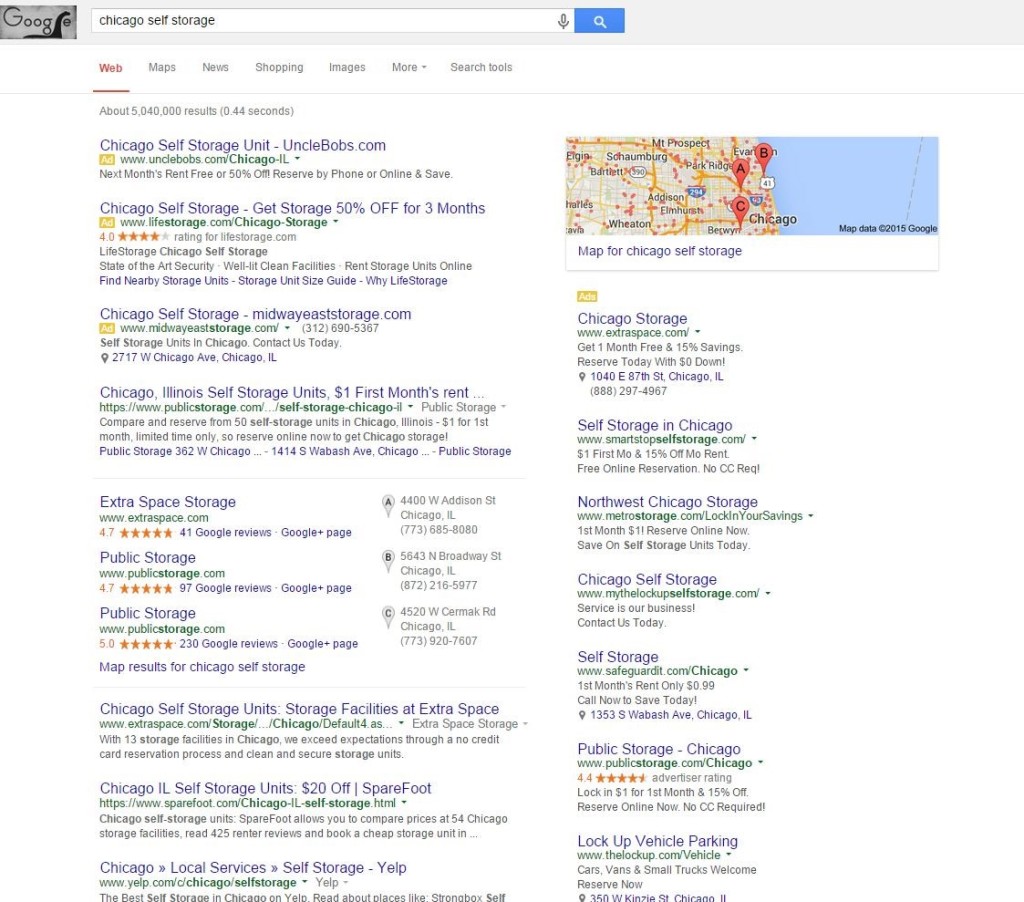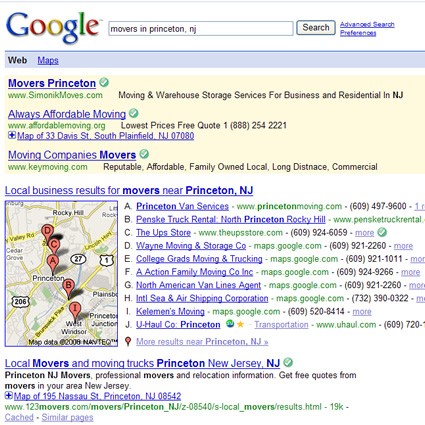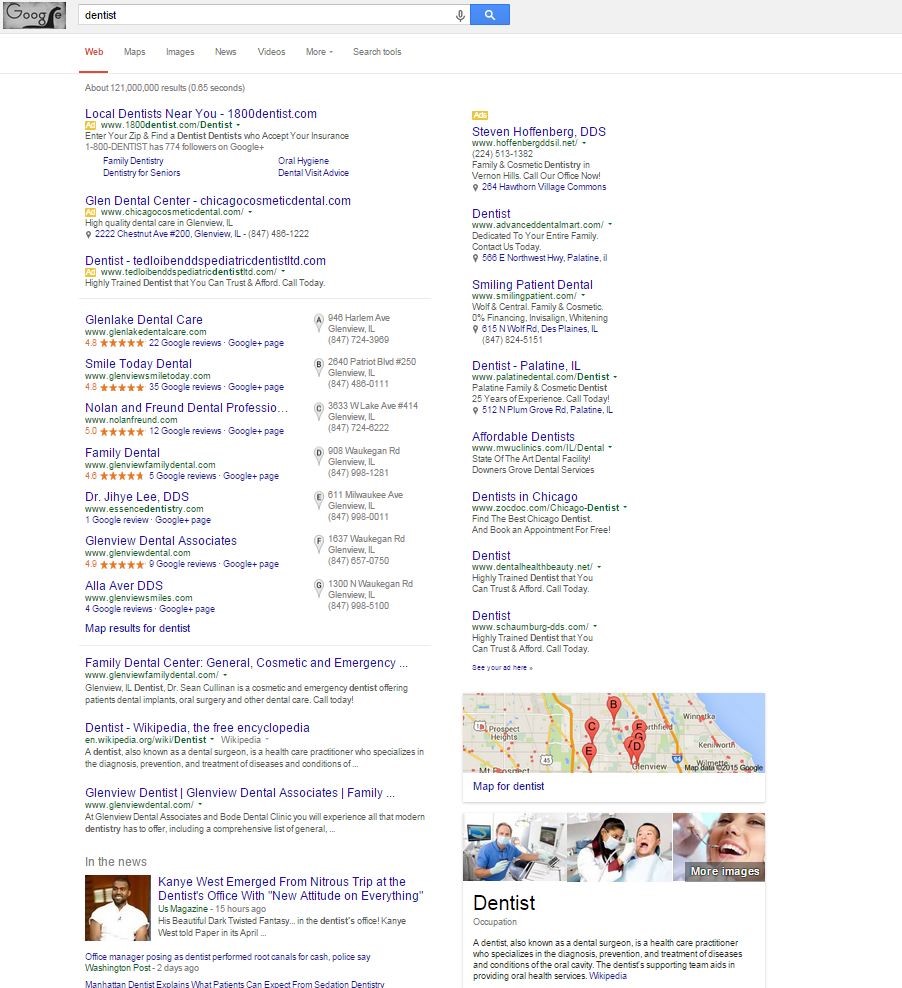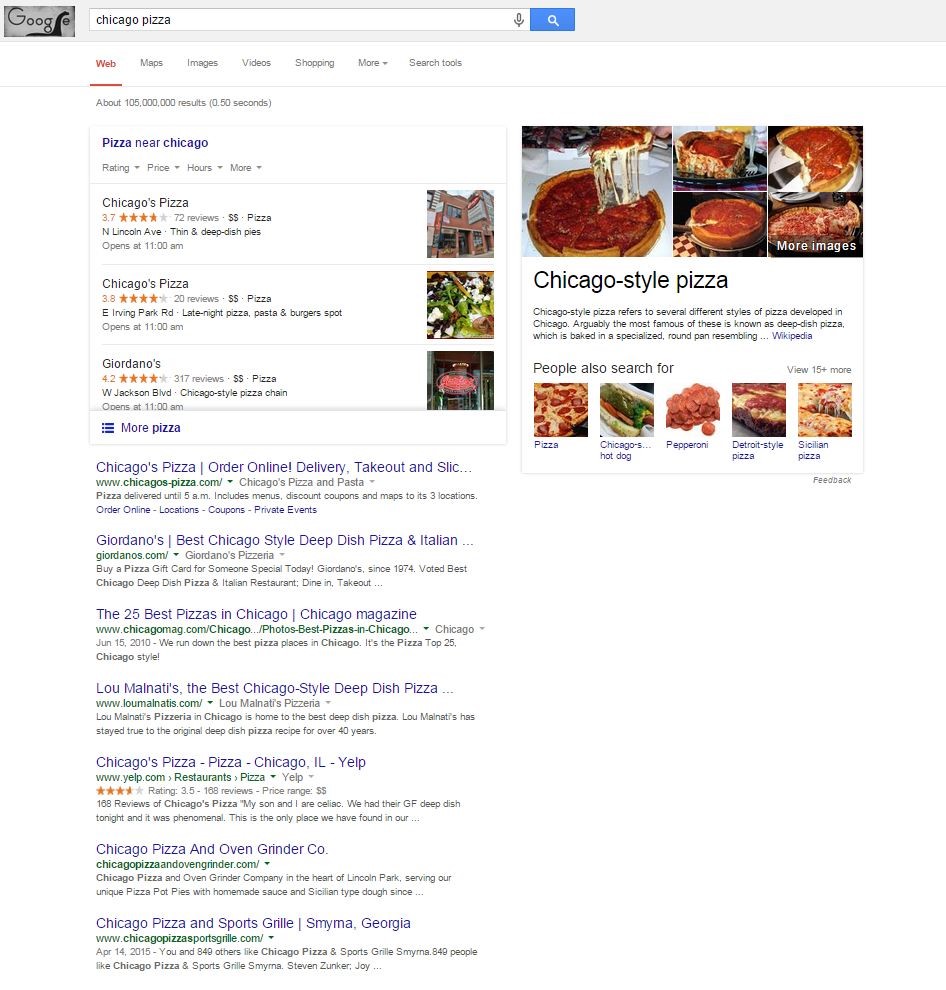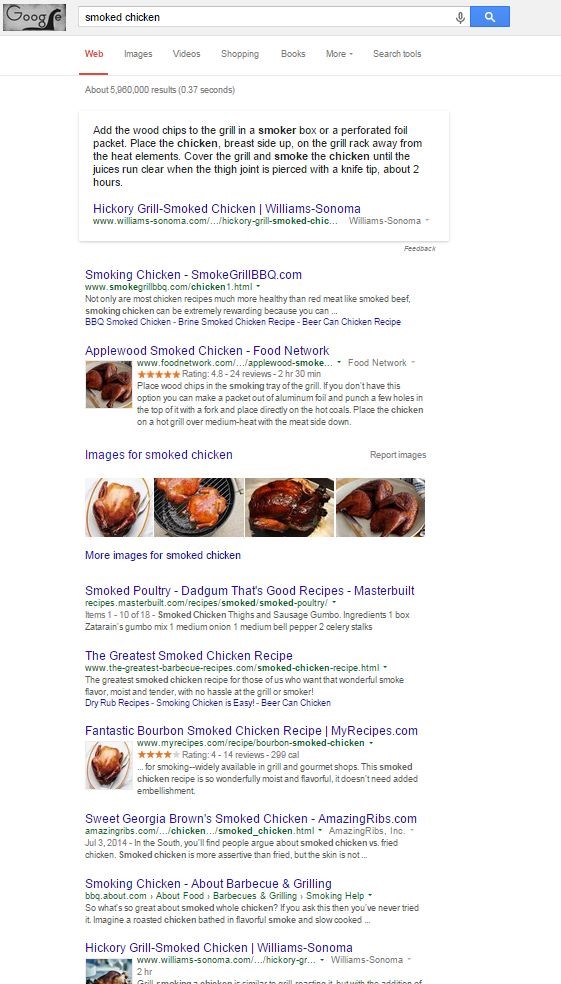The Search Engine Result Page (SERP) didn’t always look like this.
It used to look much, much different.
Then there were the 10 blue links. Remember those? Those started appearing around 2006.
Then it began dramatically changing, adding what is now considered Local Search – Maps, similar to what is shown above. The SERP started to get personalized based on websites you visited in the past, what pages you “Like” on Facebook, what pages you or your friends +1 on Google and so on until we got to where we are today – Universal Search and Blended Results.
I’ve already dropped Local, Organic and Universal Search on you within 2 minutes of reading this post. What’s the difference between Local, Organic and Universal Search you ask? Good question and one that I’ve been getting a lot lately. Let’s dig in deeper and analyze each part of the SERP.
Local Search Results
A Local Search Pack is the results within the Map section of the SERP related to the term searched. These listings typically show above the fold of the page, though are still integrated with Organic listings.
Local Search has been getting huge attention in the past couple of years as Google re-tools their algorithms. Searching phrases like “dentist” or “plumber” used to return the most optimized websites around the web. Some of those results could have been in California even though a user was searching from Florida. Search the same query now and it will be a completely different result. Google continues to gain a better understanding of users search intent and strives to give searches the best results related to their query.
Local search is a great focus for many SEO’s in recent years and refers to building signals of relevance and prominence around a specific brick and mortar business location. These signals can be reviews, citations and local links in addition to many traditional organic SEO signals (Click Thru Rate, Bounce Rate, Time on site, etc).
[tweetthis]To rank in #LocalSEO, build signals of relevance & prominence to a specific location w/citations, reviews.[/tweetthis]
Local results are what a searcher will see when searching queries such as “Dentist + city” or “City Plumber” or simply “dentist”. The results which populate the Map section of the SERP is where the Local results are displayed. It is easy to see in the picture below where I only searched “dentist”.
There are Adwords ads lining the top 3 results and the entire right hand side bar. Directly under the Ads are the Local Listings in the Map. Under Local, there are 3 Organic listings and News items.
As you can see, there typically isn’t much room for local businesses. This particular SERP has a 7 pack which is not common. With the recent Google Pigeon update last year, the Local section has shrunk from a 10 Pack of results. Some results now show a 7 Pack, as this one does, a 5 Pack or even a 3 Pack of results. This means, Local SEO’s are now in fierce competition to get their clients into the Pack as well as show up Organically. As if shrinking the 10 Pack down to 3 wasn’t enough, Local SEO’s have to focus on building strong local signals, hyper-local content, pictures, video and social signals. Oh wait, is the lawyer a bit further away from where most of the other lawyers are located or just on the outskirts of the city? Yeah…you’re going to have to work a little harder than the rest to rank here.
Google is now smart enough to know if a searcher is in Chicago and searches for “pizza” the person most likely wants pizza around the city of Chicago. Thus, Google will return results closest to where the searcher is searching from. Google still has issues doing this from queries originating from a desktop but is ridiculously accurate when the search originates on mobile. The reason results are more accurate when searching from a mobile device is because Google can pinpoint GPS coordinates from a phone. A desktop may have an IP address originating 30 miles away and thus the results will be skewed.
Beginning to see the challenges with Local SEO and how different factors come into play?
Organic Search Results
Organic Search Results are what appear in the SERP that is not in the Map (and not Adwords). These are the typical results a searcher sees when a search is performed. A search for “Chicago pizza” returned the below results.
There are no ads in this SERP as the top results show Local Listings (Snack Pack) and the Knowledge Panel on the right hand side. Under the Local listings are the Organic listings.
Organic results are what SEO’s used to focus all their efforts on. In the past, it used to be, “If you aren’t on the first page, your website will not be noticed”. This still holds true today and I’d even argue, “If you aren’t above the page fold, your website will not be noticed” but there is a huge focus on local as well. Organic SEO is still vital for many companies. Imagine telling a client their business is located in the Local results, Organic results and they have Adwords! Cannibalizing 3 spots above the fold would be a dream come true for most clients.
It is widely known that Google’s algorithm has over 200 ranking factors and is updated nearly every day. This is because Google is attempting to give users exactly what they are looking for, while removing spammy, unrelated websites. SEO’s know ranking near the top of the SERP is huge business for clients and will do anything to rank there. Thus, Google has to continually make updates and changes to their algorithm to deny the irrelevant websites from showing up. Here is a list of Google updates from Moz. It’s tough business getting clients to the top and ranking factors are constantly changing.
Organic results are based more around the business website and the goal is to rank for certain keywords. Keyword stuffing, meta data stuffing, hidden content, link building, duplicate pages and doorway pages are just a small number of spammy tactics Google has cracked down on in the past few years. SEO’s need to focus on building a solid brand, writing great content and gaining links naturally in order to rank on the first page.
[tweetthis]Ranking for #OrganicSEO is based on building a brand, linking and great content. [/tweetthis]
Issues also arise as users will see different results based on their past browsing history. Factors such as how many times they’ve visited the website before, did they +1 a page or an article, do their friends like the page/website and are they logged into their Google account will weigh on Googles algorithm and what results display.
Organic SEO still continues to show results in a similar format to the previous 8 years following the same pattern of “Title Tag, Website, Breadcrumbs and Meta Description”.
SEO continues to be an evolving marketing tactic but there are a few distinctions between Local Search and Organic Search I’d like to point out.
Local vs. Organic
To rank for Local Search, Digital Marketers need to focus on creating relevant, trusted content and creating citations to their location. Much of ranking for Local is based on citations, reviews and links. Google My Business is also a critical component as it sends many signals to Google which end up appearing in the Knowledge Graph. Social can also be a good tool for local businesses, though they should focus on creating a following to their business rather than simply posting content no one will see.
Ranking Organically is more about creating great content people will link to. Links are much more important in Organic than they are in Local. It is also much easier for brands to rank organically since they naturally attain links through their size, press and content. Social is a factor as well as brands tend to have a bigger following and can increase their Likes, Tweets, +1’s and awareness easier than local businesses can.
Universal Search Results
Back in the original days of search, listings would appear as 10 blue links, neatly lined up and arranged in text format. Marketers knew how to rank and how to outrank those websites ahead of them be it by providing quality content, changing tags or building links.
In mid-2007, Google introduced Universal Search with blended results. This was a fundamental change in how Google was displaying results in the SERP. Results were no longer simply showing 10 links in a neat, organized fashion as they also began including other types of search relevant content. The other content in the SERP’s which began showing were images, videos, news, social media, blog posts and Local pages. All of this information blended with the 10 blue links to reduce the amount of links on a page and made the page look cluttered.
The other Search Engines soon followed suit in an effort to deliver a rich, relevant user experience. The blended results are provided as information the Search Engines believe will be useful to searchers by including results from other search verticals. The result is the SERP in which we see today.
This SERP for smoked chicken shows an Answer Box at the top, two Organic listings followed by Images, and more Organic listings with pictures, reviews, ratings and videos.
Think about it for a moment. When we search for information about products today, we want to see hours, a map, driving directions, photos of the business/product and maybe video reviews related to the query. Prior to May 2007, this wasn’t possible in the SERP. A searcher would have to perform a different search for each item they wanted to find within Google. The SERP as it looks today is much more useful, user friendly and informative. These qualities are great for the SERP though it makes it that much tougher on marketers.
Prior to 2007, SEO’s only needed to worry about the 10 competitors on the first page of the SERP and how to outrank them. Now, Digital Marketers need to focus on optimizing not only the website but also video, image, blog, local, news, shopping, reviews and maps. In mid-2014, SearchMetrics released a study on Universal Search in the SERP’s and found that in 85% of searches, there was some element of Universal Search. In addition, videos appeared in 65% of results, 40% for images and 16% for news.
Another challenge for Marketers is dealing with all of the content/information on the SERP. Since there is so much information on the page, users tend to get distracted. Photos and videos tend to break up the SERP and cause user eyes to wander. In addition, just because there is more information on the page doesn’t mean the information is necessary or useful as it is difficult for Marketers to optimize video and images. More information can be great for users and Marketers but it can also be overwhelming for both sides.
Lastly, blended results seem to favor larger companies simply for the fact they can employ more people to the optimization process than a smaller company can. Large companies may already have a number of people optimizing for content, blogs, videos, images and social media where a smaller company may only have 1 person performing the same tasks. This isn’t always the case but more often than not rings true. Strength and power in numbers!
What Can Marketers Do
Despite what I wrote above, it’s not all gloom and doom for Digital Marketers – much to the contrary. Just as having all the blended results in the SERP’s can be a pain to navigate for Marketers, it can also be a huge advantage. There are new opportunities for high profile exposure and additional market penetration. There are new opportunities to learn additional optimization techniques, opportunities to carve out a niche and opportunities to gain a competitive advantage.
[tweetthis]Universal Search gives SEO’s more opportunities to get their clients ranking. #SEO [/tweetthis]
Digital Marketers need to determine which areas are worth the time, effort and man power and which are not. This can be a difficult task because what works in one industry may not work in another. The game is constantly changing and Digital Marketers need to be able to adapt in order to thrive.
What are you as Digital Marketers or your companies doing to take advantage of Universal Search?
